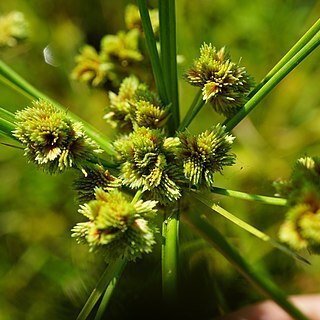Herbs, perennial, cespitose; rhizomes upright, 5–8 mm diam., indurate. Culms trigonous, 30–50(–80) cm × 1.8–2.5 mm, glabrous. Leaves 4–7(–10), V-shaped, (20–)40–60 cm × 4.5–8 mm. Inflorescences: heads dense, hemispheric, 7–15(–18) mm diam; or if rays absent, heads dense, irregularly lobate, 2–3.5 cm diam.; rays 3–6, 1–30 mm; 2d order rays infrequently present, to 5 mm; bracts (5–)10–15(–40), horizontal to ascending at 30(–45)°, V-shaped, 6–30(–40) cm × 5–8(–10) mm. Spikelets 40–100, greenish white, flattened, ovoid, 3.5–5 × 3–4 mm; floral scales (8–)12–16, uniformly light greenish to light brown, laterally 1-ribbed, medially indistinctly 3-ribbed, basally 2-keeled, oblong-spatulate, widest at or above median, 2–2.5 × (0.7–)1–1.2 mm, apex minutely mucronate, scabridulous, infrequently glabrous. Flowers: stamen 1; anthers oblong, 0.7–1 mm, connective apex subulate, prolonged 0.1–0.2 mm; styles thick, confluent with apex of, and persistent on, achene, 0.5–0.8 mm; stigmas 0.6–1 mm. Achenes brown, stipitate, linear, slightly curved, 1.2–1.4 × 0.2(–0.3) mm, base whitish, stipe spongy, 0.1–0.2 × 0.2 mm, apex acute, surfaces papillose.
More
Tufted perennial 3–8 dm; lvs elongate, often surpassing the stem, mostly 4–6 mm wide but conduplicate; bracts 4–8, much surpassing the infl; rays usually well developed, each bearing a terminal glomerule of spikes, or occasionally suppressed, producing a compact infl; spikes ovoid or subglobose, very dense, 7–15 mm; spikelets flat, ovate, 2–5 × 1.5–3 mm, closely imbricate with their flat sides together, (6–)10–22-fld; scales 1.5–2.5 mm, falcately incurved-ascending with divergent tip, in side-view with parallel sides, distinctly bicarinate basally; rachilla persistent, wingless; stamen 1; achenes linear-trigonous, 1–1.5 mm. Swamps and marshes; N.J. to Fla., w. to Ill., Mo., Okla., and Tex. Sometimes confused with C. virens, a more s. sp. not reaching our range.

